If you’ve ever wondered what the average bicep size is for men, women, teenagers, or bodybuilding athletes, then this arm girth guide is for you.
Based on real-world data and decades of combined strength training experience, our team has created various bicep size charts so that you can learn how your biceps circumference compares to people in your particular category.
After that, we’ll show you how to measure your biceps accurately so that you don’t get an overinflated reading.
Additionally, you’ll learn the critical factors that influence your arm size and discover how you can manipulate them to increase or decrease your bicep measurement.
See How You Stack Up:
- 10 inch arms
- 11 inch arms
- 12 inch arms
- 13 inch arms
- 14 inch arms
- 15 inch arms
- 16 inch arms
- 17 inch arms
- 18 inch arms
What is the average male bicep size?

What is the average male bicep size among the general population?
Based on research carried out by the Centers for Disease Control and Prevention during 2015-2018, the average man’s bicep size is right around 13.5 inches. [1]
This bicep circumference data is based on a sample size of 781 men and is likely an unflexed measurement due to these statistics being taken from the general population (i.e., not bodybuilders).
The same set of anthropometric reference data includes measurements for 7 different categories, all of which are based on age. For example, the average arm size for a man between the ages of 30-39 is 14 inches.
We based our average biceps size on the 20-29 age range because, in our experience, it’s mostly younger men who want to learn about and measure their bicep girth.
Check out the male biceps chart in the next section to get a full breakdown of the average arm size by age.
You can also see our average forearm size guide to learn about the most common lower arm sizes.
What is the average bicep size for females?

What is the average female bicep size, according to the research?
Based on the same anthropometric reference data quoted above, which was published in 2021, the average female bicep circumference is 12.5 inches. [1]
This upper arm measurement is taken from the 20-29 age range and is based on a sample size of 799 women.
The lowest average female arm circumference—11.65 inches—was found amongst women aged 80+. Comparatively, the highest female biceps measurement—13.11 inches—was observed in the 40-49 age group.
Since the biggest female biceps were observed on middle-aged women, this could be an indication that younger ladies tend to exercise more frequently and consume a lower calorie diet.
See Also: Average male chest size│Average shoulder width
What is the average biceps size for teenagers?

While the average bicep size for a teenager depends on the gender of the teen, the difference in upper arm measurements between male and female children and adolescents isn’t as significant as you might think.
Notably, based on the 2021 data from the National Center for Health Statistics, the difference in bicep measurements between male and female teenagers becomes more pronounced the older that the participants get.
For example, the average bicep circumference of 4-year-old children is 6.89 inches for both males and females. [1]
At 7 years of age, the average bicep measurement is actually larger for females (7.80 inches vs 7.95 inches).
However, by 19 years of age, the differences become much more pronounced. At this point, the average teenage bicep size is 12.8 inches for males and 12.05 inches for females.
This difference would likely be even greater if the measurements were taken when the biceps were flexed rather than relaxed.
Average bicep size chart by gender and age
The following statistics are taken from 2021 anthropometric data published by the National Center for Health Statistics.
This organization is a US governmental agency that, among other things, collects a variety of health and wellness data, an example of which is the average arm circumference. [2]
In addition to viewing the arm size charts below, you can also read the following articles to gain an understanding of what is considered big biceps (the links for 10 to 18 inch bicep sizes can be found after the introduction of this article).
- 19 inch biceps
- 20 inch biceps
- 21 inch biceps
- 22 inch biceps
- 23 inch biceps
- 24 inch biceps
- 25 inch biceps
- 26 inch biceps
- 27 inch biceps
- 28 inch biceps
- 29 inch biceps
- 30 inch biceps
Biceps size chart (adult males)

As you can see on the biceps size chart, the average upper arm circumference for a man peaks in the 30-39 age range. After 40, the average bicep size for a man decreases at every surveyed age, where it bottoms out at 12.13 inches.
This valuable data, which is based on a sample size of 4,919 men, strongly suggests that a man loses some of his arm mass as he ages, especially after reaching the age of 70.
The fact that men between the ages of 60-69 have a larger biceps measurement than men between the ages of 20-29 is a clear indicator that the circumference measurements weren’t taken with the biceps in a flexed state.
Similarly, the reason that the average male bicep size is higher in the 30-39 age range than in the 20-29 age range may be due to the fact that younger men tend to have leaner physiques than older men.
Arm size chart (adult females)
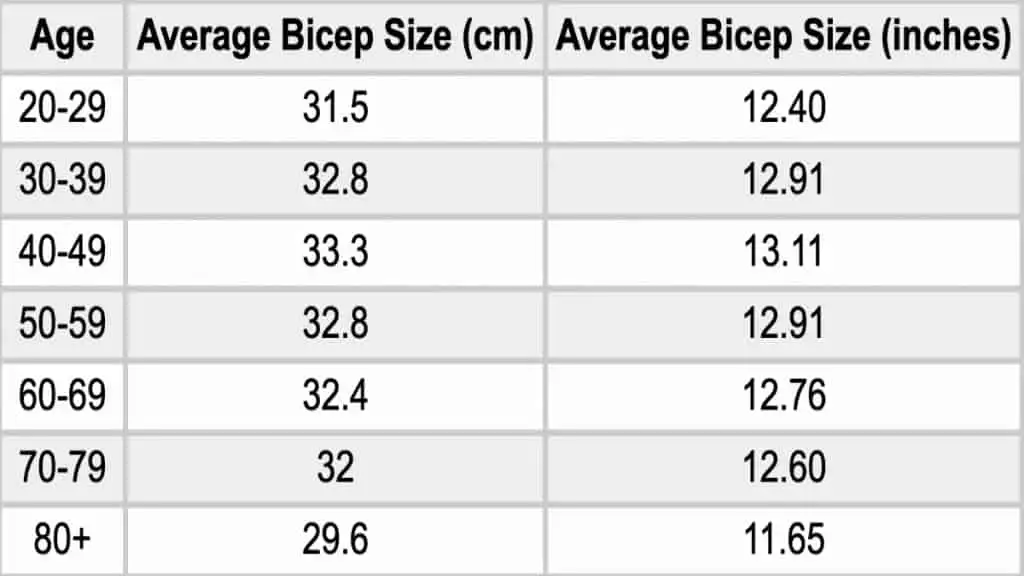
Based on a sample size of 5,140 women, the average arm circumference for females tends to peak between the ages of 40-49, which is 10 years later than the average male biceps size peaks.
After the age of 50, the average biceps size for women decreases, reaching its lowest measurement (11.65 inches) in the 80+ age bracket.
Based on the data, younger women typically have slightly smaller bicep sizes than older women.
For example, the average arm size for a woman between the ages of 20 and 29 is 12.4 inches, whereas the same measurement is 12.76 inches for ladies in the 60-69 age group.
This difference in circumference may be due to the fact that, according to some research, younger women are more likely to exercise regularly than older women, [3] which in turn helps them to maintain a lower BMI and thereby a smaller bicep circumference.
Bicep measurement chart (male children and adolescents)
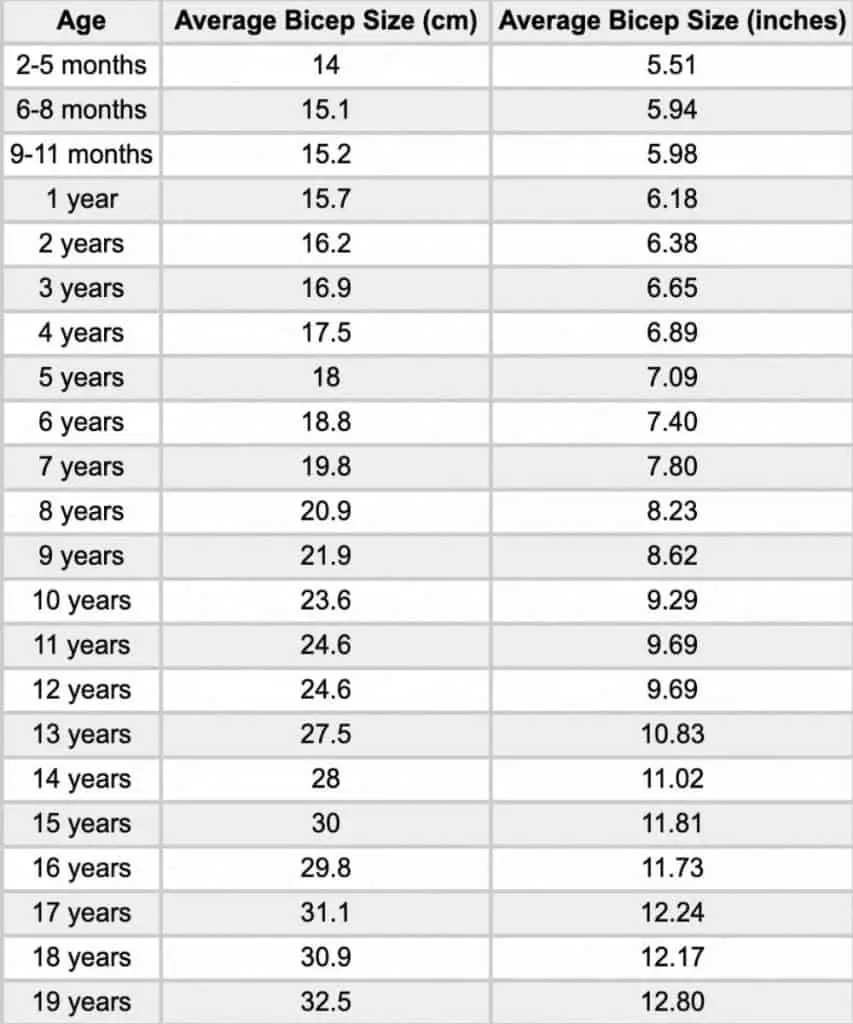
The average male bicep circumference for children and adolescents is heavily dependent on the age of the participant and, in fact, increases at every surveyed age up until 15.
It’s evident from the data that male children and adolescents have a larger average arm size than female children and adolescents.
Out of 22 surveyed ages, the male participants had a bigger upper arm girth on 13 occasions. Girls had a bigger measurement on 7 occasions, and twice the surveyed participants were tied.
Bicep circumference chart (female children and adolescents)
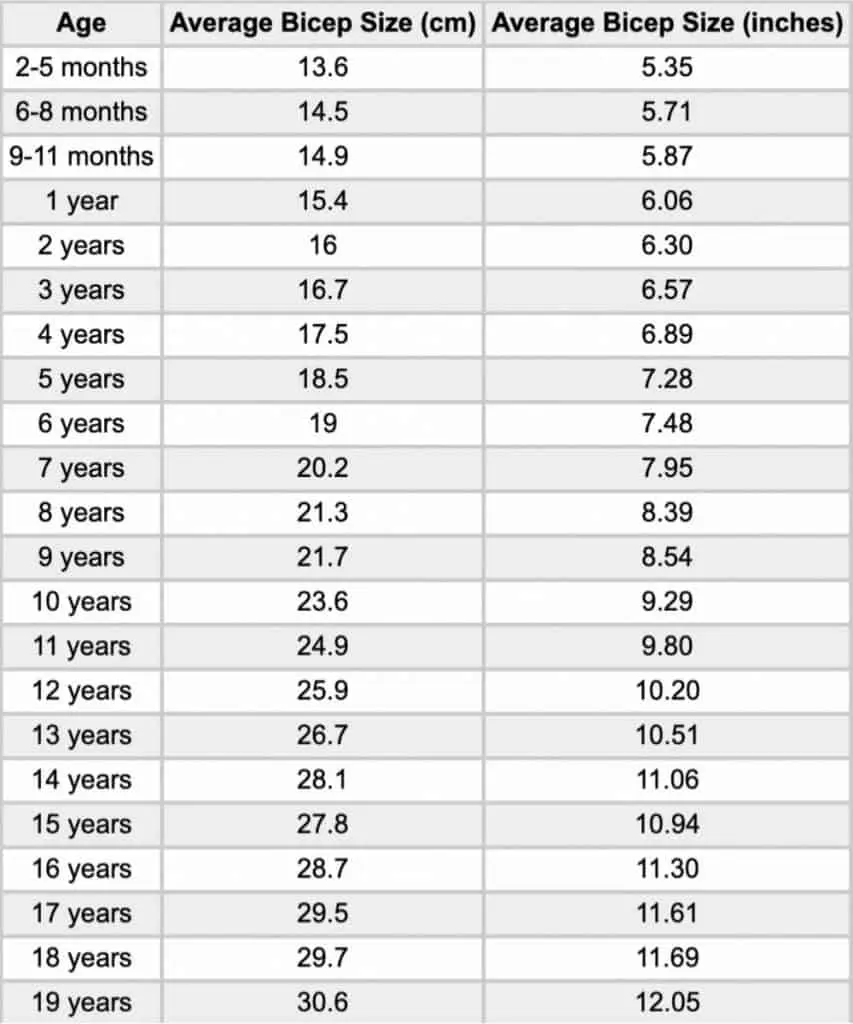
In a similar manner to the measurements of the male children and adolescents, the average female bicep size increases consistently at every surveyed age up until 14.
Out of the 7 occasions where girls had bigger bicep measurements than boys, 4 of these were recorded between the ages of 4 and 7, which is to say before puberty.
See Also: 8 inch biceps│9 inch biceps
How to take an accurate bicep measurement

Learning how to measure your arms accurately is important because precise circumference measurements give you a reliable gauge of your resistance training improvements, your weight loss progress, and if you or your child is still growing, your physical development.
Before you learn how to measure your arm size, you need to decide whether you want to record your flexed bicep size or your unflexed bicep size.
While most research uses the unflexed measurement for the sake of simplicity and consistency, it’s recommended to take a flexed measurement if you want to get an accurate gauge of your actual bicep muscle mass.
As for the best bicep measuring tape to use, any clothing tape will work as long as you can keep it close to your skin. So go for a plastic bicep tape measure rather than a metal one.
If you’re measuring your arms alone, then you’ll be best off getting a tape measure that you can lock in place while you flex.
Additionally, always make sure to measure around the tallest, most peaked part of your biceps so that the measurement truly reflects your biceps development.
With that said, here’s how to measure your biceps correctly:
- Stand up straight, raise your arm out to the side, and then rotate your palm so that it’s facing up.
- Flex your biceps by moving your fist toward your head.
- Get someone to wrap a measuring tape around the thickest part of your biceps. You can do this with your spare arm if nobody is around to assist you.
- Take note of where the ends of the tape begin to overlap. This is your biceps circumference.
- You can optionally take a couple more measurements to ensure that your reading is accurate. Similarly, you may also want to measure your other arm so that you can identify any bicep size asymmetries.
What factors affect the average arm size?
Now that you know the normal bicep size for each major population group, it’s time to learn the factors that affect your bicep size, muscularity, and aesthetics.
Genetics

Your genetics, in particular, your body mass index (BMI), is the primary determinant of your upper arm circumference.
The relationship between bicep size and BMI is well established in general populations because those with a larger body mass also tend to have bigger upper arms. [4]
Of course, this relationship doesn’t always extend to those who perform regular strength training. For example, if you have muscular biceps and a relatively low body fat level, then your bicep measurement may indicate that your BMI is high when it’s, in fact, normal.
This is because muscle hypertrophy is a local process. So it’s entirely possible to significantly increase the size of your biceps (which are a relatively small muscle group) without gaining much extra body weight.
Additionally, the shape of your biceps can affect your upper arm measurement. If you have tall and very peaked biceps as opposed to longer, flatter biceps, then you’ll likely record a bigger arm measurement.
Read More: Average hip size
Training status
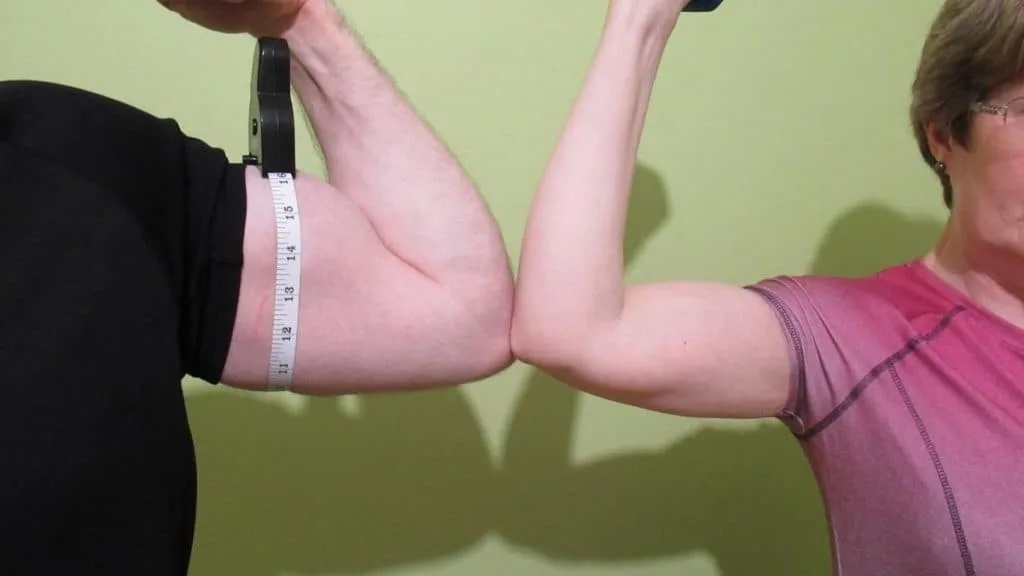
Resistance training is a highly effective exercise modality for improving your body composition. In particular, lifting weights can increase your fat-free mass and make your muscles larger in circumference. [5]
Common sense dictates that people who’ve been training their biceps for years will have bigger biceps than those who’ve just started hitting the gym.
Yet, training status, from a hypertrophy-training perspective, isn’t determined by how many years you’ve been faithfully showing up to the gym.
First and foremost, training status is determined on a per muscle basis. In this regard, it’s theoretically possible for your biceps to be enormous and thereby “advanced,” but that your triceps are tiny and therefore still at the novice stage of their development.
Your bicep genetic potential is also relative. You need to factor in your height, weight, and wrist circumference in order to determine how big your arms can realistically get.
As such, it’s entirely possible for you to have smaller biceps than your friend while simultaneously having better, more advanced development than him (if he has a higher potential bicep circumference due to his genetics).
Diet

If you want to attain the ideal bicep size, then it’s not enough to merely perform chin-ups and curls; you need to consume sufficient protein as well.
Research from the European Journal of Clinical Nutrition shows that protein intake and the number of high protein meals that you consume is associated with lean mass and muscle cross-sectional area (those who consumed more protein had more muscle mass). [6]
This study was conducted using the vastus lateralis, which is a quadriceps muscle. However, the results are also applicable to biceps size because the muscles that benefit from the increased protein intake the most (by getting bigger) are those that you train directly with resistance.
Eating in a calorie surplus can also help you to achieve a big bicep size. This is because a calorie surplus provides your body with some extra energy that it can use to trigger hypertrophy. [7]
Gender

In general, men have higher levels of fat-free mass than women, who tend to store more body fat, particularly around the legs and hips. [8]
Men also have larger frames than women on average, and frame size is positively associated with fat-free mass. [9]
Interestingly, research shows that after 10 weeks of bicep training, men and women gained a similar amount of strength (11.61% for men and 11.76% for women). [10]
However, men still registered much higher overall bicep strength.
So even though the strength increase was marginally higher in women, it’s clear that men have stronger biceps overall—strength that can be used to provoke muscle hypertrophy, which leads to a bigger arm circumference.
Read More: Average calf size│Average neck size
Body fat levels

Upper arm fat is not the same as biceps muscle mass.
It’s entirely possible for you to have more biceps mass than someone and yet still record a smaller measurement due to having less body fat on your arms.
Body fat is also the reason why you might think that you have average size biceps when in reality, they’re much bigger than the data would suggest.
This is because most biceps circumference measurements are taken unflexed, meaning that the biceps can’t display their full muscularity because they’re relaxed.
It’s not uncommon to see a 2 inch difference between your unflexed and flexed bicep size!
Similarly, since BMI doesn’t take into account your body fat, it’s not an accurate predictor of your biceps muscularity (though it’s still useful for predicting upper arm mass in some populations).
Related: Average thigh size│Average waist size
What is considered “big arms”?

What are considered big arms? It depends on who you ask and also the age, height, gender, body fat level, and training status of the person.
For example, 14 inch arms flexed are big for a woman but not particularly big for a man.
However, if that man is of shorter stature with a smaller frame, then such a measurement is actually a very good bicep size and may look much bigger than the tape suggests.
Similarly, 15 inch arms might be impressive for a sportsman or recreational lifter but less so for a bodybuilder that lives in the gym.
In general, though, if you ask most people who lift, “what are good sized arms?” then the majority of strength trainees will likely say around 16 inches.
Anything over 16 inches is very big, and anything north of 18 inches is colossal.
These measurements presume that your arms are relatively lean. You certainly don’t need to be shredded, but if you want to get an accurate indication of your bicep muscularity (not just “size”), then you need to be able to see some decent definition when your arms are flexed.
Average bicep circumference FAQ
This section covers an array of topics, including the ideal biceps size and length. It also reminds you how to measure your arm size accurately.
What is the average flexed bicep size?
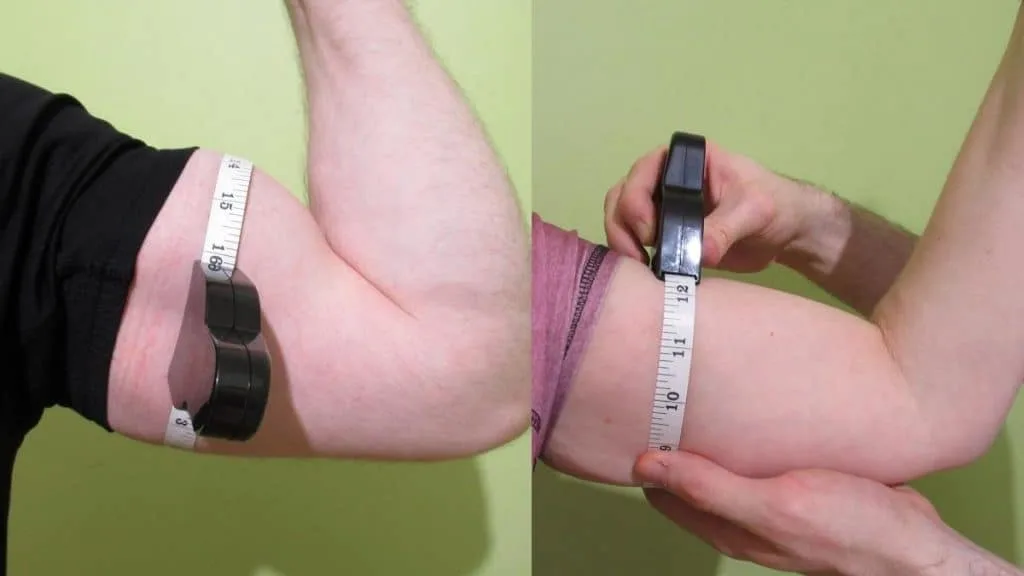
Based on observing the measurements of numerous natural weight lifters and bodybuilders, the average flexed bicep size is right around 15 inches.
Broadly speaking, most people with average genetics and a normal frame size will have between 14 and 16 inch arms when they’re relatively lean.
Additionally, those with better bicep peaks (i.e., taller biceps) will typically record a larger bicep measurement than those with longer, flatter biceps.
You needn’t have the biggest arms in the world to have impressive-looking biceps. Having lean, nicely-shaped biceps can make your arms look a lot bigger than they actually are, especially when flexed or posed.
What is the ideal bicep size for my height?

We did not include a chart showing the average bicep size by height because no such data exists.
Yet, just because there’s no published research showing the average arm size by height doesn’t mean that we can’t might good assumptions based on repeated in-person observations.
It’s clear that taller people have bigger frames than people of a shorter stature. Having a large frame rather than a small frame means that your biceps have more growth potential.
Yet, people with larger frames also need to build their biceps to a much higher measurement for their arms to look muscular.
For example, 15 inch arms will look very impressive on someone 5′7″, especially if that person is relatively lean. However, the same arm size would look much smaller, perhaps even skinny, on someone who’s 6′4″.
What’s a good arm size for a 6 foot person?
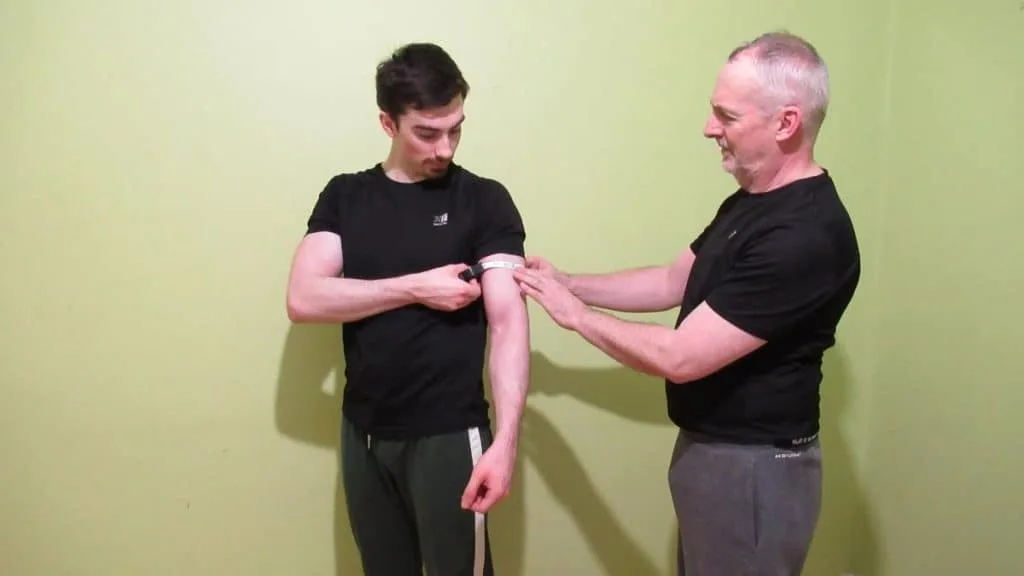
A good flexed arm size for a 6 foot person (183 cm) who lifts weights regularly is 14.5 to 16.5 inches.
If you have a lower body fat level, then your arms will look impressive at a smaller size.
If you have a higher body fat level, on the other hand, then at 6 feet, you’ll need to bulk your arms up to the 16 inch mark for them to look impressive.
These estimates are based on measurements taken from 6 foot weight lifters.
How do you measure your arms correctly?

Learning how to measure your bicep size correctly is crucial if you want to get accurate readings.
Getting someone else to measure your arms is recommended so that you can concentrate on flexing your biceps.
But if you don’t have anyone around to measure your biceps (or if you’re too embarrassed to ask for assistance), then you can also take your own measurement.
In this scenario, your best bet is to use a biceps measurement tape that you can lock into place so that it doesn’t come loose and lead to an inflated reading.
How do you take a proper bicep length measurement?
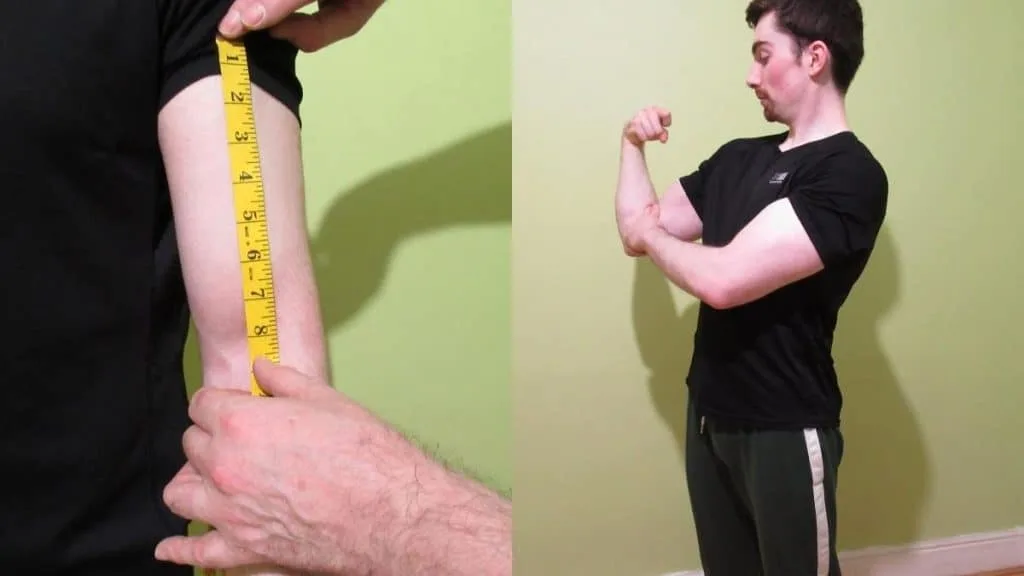
There are two ways to measure your bicep length.
One, you can measure the length of the actual bicep muscle when it’s relaxed. As you can see from the picture, this is self-explanatory.
The other option, which you can use to determine whether you have peaked or flat biceps, is to flex your biceps and then put as many fingers between your biceps and forearms as you can. The more fingers that you can fit in the gap, the longer and flatter your biceps are likely to be.
Read More:
Conclusion: Is knowing your bicep measurement useful?

Knowing the average bicep size for your age and gender can help you to track your strength training gains and weight loss progress.
Such information can help you to evaluate whether your current training program and dietary regime are working or whether you need to make a change.
Having knowledge of the average arm size in the general population is also helpful for health practitioners because upper arm circumference is positively correlated with BMI.
Since arm measurements done with a tape don’t take your body fat level into account, these measurements don’t necessarily provide an accurate representation of biceps muscularity.
However, experienced exercise professionals and trained weight lifters generally have a good eye for what is muscular and what is not. As such, it’s recommended to take into account your body fat in addition to your arm size if you want to get an accurate bicep measurement.
References
- Centers for Disease Control and Prevention. (2021, January). Anthropometric Reference Data for Children and Adults: United States, 2015–2018 (National Center for Health Statistics). United States Department of Health and Human Services. https://www.cdc.gov/nchs/data/series/sr_03/sr03-046-508.pdf
- Mission, Role and Pledge. (2019, May 13). Centers for Disease Control and Prevention. https://www.cdc.gov/about/organization/mission.htm
- Rhoades, J. A. (2005, February). Exercise in Adults, Age 18 and Older, in the United States, 2002: Estimates for the Noninstitutionalized Population. Agency for Healthcare Research and Quality. https://meps.ahrq.gov/data_files/publications/st70/stat70.pdf
- Benítez Brito, N., Suárez Llanos, J. P., Fuentes Ferrer, M., Oliva García, J. G., Delgado Brito, I., Pereyra-García Castro, F., Caracena Castellanos, N., Acevedo Rodríguez, C. X., & Palacio Abizanda, E. (2016). Relationship between Mid-Upper Arm Circumference and Body Mass Index in Inpatients. PLOS ONE, 11(8), e0160480. https://doi.org/10.1371/journal.pone.0160480
- Cullinen, K., & Caldwell, M. (1998). Weight Training Increases Fat-Free Mass and Strength in Untrained Young Women. Journal of the American Dietetic Association, 98(4), 414–418. https://doi.org/10.1016/s0002-8223(98)00094-7
- Hayashi, A. P., de Capitani, M. D., Dias, S. F., de Souza Gonçalves, L., Fernandes, A. L., Jambassi-Filho, J. C., de Santana, D. A., Lixandrão, M., Tavares Dos Santos Pereira, R., Riani, L., Hevia-Larraín, V., Pereira, R. M. R., Gualano, B., & Roschel, H. (2020). Number of high-protein containing meals correlates with muscle mass in pre-frail and frail elderly. European Journal of Clinical Nutrition, 74(7), 1047–1053. https://doi.org/10.1038/s41430-020-0618-3
- Slater, G. J., Dieter, B. P., Marsh, D. J., Helms, E. R., Shaw, G., & Iraki, J. (2019). Is an Energy Surplus Required to Maximize Skeletal Muscle Hypertrophy Associated With Resistance Training. Frontiers in Nutrition, 6. https://doi.org/10.3389/fnut.2019.00131
- Abe, T. (2003). Sex differences in whole body skeletal muscle mass measured by magnetic resonance imaging and its distribution in young Japanese adults. British Journal of Sports Medicine, 37(5), 436–440. https://doi.org/10.1136/bjsm.37.5.436
- Chumlea, W. C., Wisemandle, W., Guo, S. S., & Siervogel, R. M. (2002). Relations between frame size and body composition and bone mineral status. The American Journal of Clinical Nutrition, 75(6), 1012–1016. https://doi.org/10.1093/ajcn/75.6.1012
- Gentil, P., Steele, J., Pereira, M. C., Castanheira, R. P., Paoli, A., & Bottaro, M. (2016). Comparison of upper body strength gains between men and women after 10 weeks of resistance training. PeerJ, 4, e1627. https://doi.org/10.7717/peerj.1627

